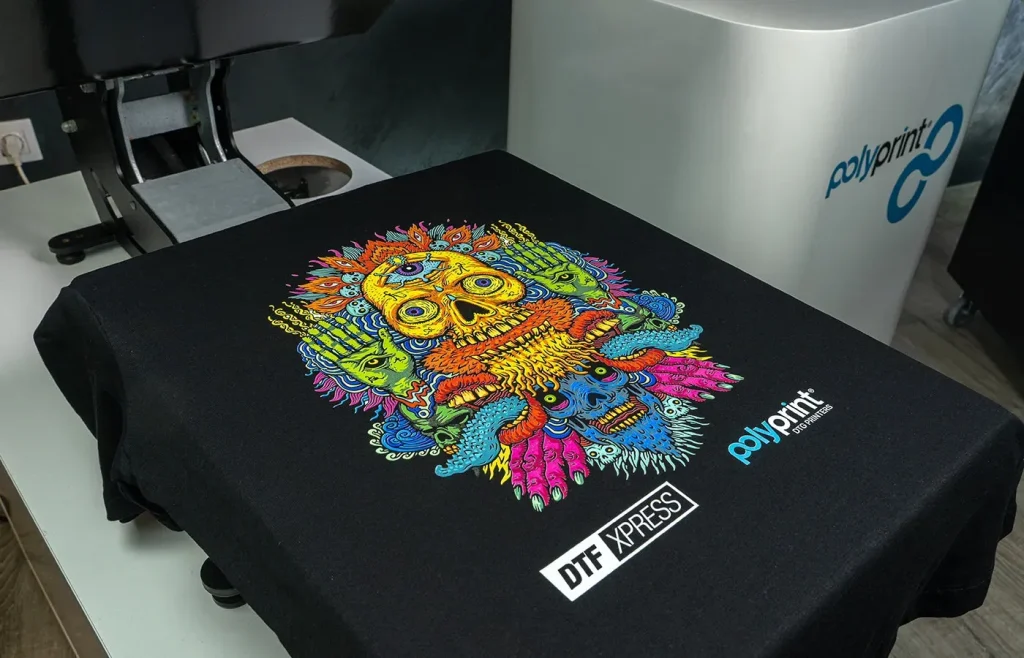DTF printing, or Direct-to-Film printing, is revolutionizing the world of sustainable fashion printing by offering brands an innovative way to produce high-quality designs with minimal environmental impact. As the demand for environmentally friendly inks and minimal waste production increases, this advanced printing technology stands out as a frontrunner in meeting shoppers’ desires for sustainable choices. Unlike traditional methods, DTF printing prioritizes energy-efficient printing processes, ensuring that garment production becomes greener and more responsible. This approach not only supports small business printing needs by allowing for on-demand production but also appeals to eco-conscious consumers looking for stylish and sustainable clothing options. With DTF printing, brands can build a legacy of ethical practices while satisfying the growing consumer push for sustainable fashion solutions.
Direct-to-Film printing, often abbreviated as DTF printing, represents a groundbreaking technique in the realm of eco-friendly fashion production. This innovative method enables artists and small businesses to create vibrant, sustainable designs with significantly reduced waste and energy consumption. By leveraging environmentally friendly inks, DTF printing aligns perfectly with the increasing consumer demand for responsible fashion practices. Its adaptability makes it an ideal solution for enterprises seeking to improve their ecological footprint while satisfying their clientele’s desire for stylish attire. In essence, DTF printing is not just a printing method; it’s a key player in shaping the future of responsible apparel production.
The Role of DTF Printing in Sustainable Fashion
Direct-to-Film (DTF) printing represents a significant leap forward in sustainable fashion practices, with its ability to produce high-quality prints with minimal environmental impact. Unlike traditional printing methods that generate vast amounts of waste, DTF allows for on-demand production, meaning garments are only made as needed. This feature aligns closely with the principles of sustainable fashion, where reducing waste is paramount. Additionally, DTF printing utilizes eco-friendly inks that are void of harmful chemicals, making it safer for both consumers and the environment.
Moreover, the adaptability of DTF printing serves as a vital tool for fashion brands looking to embrace sustainability. By facilitating a more efficient workflow, DTF reduces the reliance on extensive inventories that often lead to unsold stock and additional waste. This approach not only conserves resources but also helps brands respond swiftly to market trends, ultimately aligning production more closely with consumer demand. The integration of DTF technology into the fashion industry marks a pivotal shift towards more responsible practices, ensuring that fashion remains both stylish and sustainable.
Minimizing Waste with DTF Printing
One of the most compelling aspects of DTF printing is its capacity to significantly minimize waste during the garment production process. Traditional methods often incur substantial excess through misprints, setup failures, and overproduction, leading to an unsustainable cycle of material waste. DTF printing, however, allows for precision in printing, where only the necessary quantities are produced based on actual orders. This proactive approach to manufacturing reduces fabric scraps and eliminates the need for large storage spaces filled with unsold items, contributing to a more sustainable model of production.
As the demand for sustainable solutions grows, brands employing DTF technology are not just addressing consumer concerns but are also paving the way for less wasteful practices in the fashion industry. By producing only what is needed, companies can optimize their material consumption and ensure that every piece of fabric is utilized effectively. This minimal waste production process not only helps reduce the ecological footprint of the fashion industry but also aligns with the principles of sustainable development that prioritize conservation and efficiency.
Energy Efficiency in DTF Printing Processes
Energy consumption is a significant concern in the fashion industry, especially within garment printing processes. Traditional printing methods often rely on high energy inputs, contributing to the sector’s carbon footprint. DTF printing stands out as a more energy-efficient alternative, using less power to achieve comparable, if not superior, print quality. This reduction in energy consumption is crucial in an industry where practices are being scrutinized for their environmental impact, and it demonstrates a brand’s commitment to adopting greener technologies.
Additionally, by utilizing DTF technology, brands can significantly lower their operational costs associated with energy use. As companies seek to balance profitability with sustainability, the energy-efficient aspect of DTF printing allows for a more financially sustainable model. As the fashion industry continues to embrace energy-efficient printing methods, the shift towards DTF technology exemplifies a broader commitment to environmental stewardship, marking it as an essential innovation in sustainable fashion.
The Benefits of Environmentally Friendly Inks in DTF Printing
The inks used in DTF printing play a crucial role in establishing its reputation as a sustainable printing method. Unlike traditional inks that may contain harmful chemicals, DTF printing utilizes non-toxic, environmentally friendly inks that are safe for both users and the planet. This shift towards safer materials is increasingly necessary as consumers demand transparency and sustainability in the products they purchase. Employing such inks not only enhances the appeal of the printed garment but also minimizes the chemical exposure associated with conventional printing methods.
Furthermore, the use of environmentally friendly inks reflects a brand’s dedication to sustainable fashion practices. Brands committed to using these safer alternatives are better positioned to attract environmentally-conscious consumers, enhancing their marketability. In a world where sustainability is becoming a significant factor in purchasing decisions, DTF printing’s reliance on eco-friendly inks sets a positive precedent and encourages a broader movement towards greener production practices within the textile industry.
Empowering Small Businesses through DTF Technology
DTF printing technology is particularly beneficial for small businesses and independent creators, empowering them to operate more sustainably. One major advantage is the reduced necessity for large inventory storage. Small businesses often face the challenge of overproduction, which leads to surplus inventory and wastage. DTF allows them to print apparel on-demand, eliminating the risks of unsold stock while ensuring that they can respond nimbly to customer trends.
Moreover, DTF provides a cost-effective solution for startups striving to introduce their designs without a hefty upfront investment in inventory. This flexibility in production not only supports the business model of small enterprises but also contributes to the overall trend of minimal waste production. By embracing DTF printing, small businesses position themselves as leaders in the sustainable movement, effectively marrying creativity with ethical practices and forming a more responsible approach to fashion.
Consumer Preferences Driving Sustainable Fashion Innovations
A significant driver of DTF printing’s rise in popularity is the ongoing shift in consumer preferences towards sustainability. Today’s consumers are more informed and conscious of the environmental impact of their purchasing decisions, often favoring brands that demonstrate real commitment to eco-friendly practices. DTF printing not only meets these demands but also provides stunning, high-quality designs that resonate with consumers seeking both style and sustainability. Brands that utilize DTF technology effectively cater to a growing market of eco-conscious buyers, positioning themselves for long-term success.
Furthermore, the alignment between consumer values and brand practices is crucial for maintaining customer loyalty in an increasingly competitive landscape. By adopting DTF printing, brands showcase their dedication to reducing environmental impact, utilizing innovative processes, and promoting sustainable fashion. This synergy between consumer expectations and brand responsibility is pivotal in fostering an industry that not only thrives economically but also champions ecological and ethical initiatives to contribute positively to the environment.
Frequently Asked Questions
What is DTF printing and how does it contribute to sustainable fashion printing?
DTF printing, or Direct-to-Film printing, is an innovative technique that prints designs onto a special film which is then heat-transferred to fabric. This method contributes to sustainable fashion printing by minimizing waste production, as brands only print what is needed, thus reducing excess inventory. Additionally, DTF printing requires less energy than traditional methods, making it more environmentally friendly.
How does DTF printing reduce waste in the fashion industry?
DTF printing significantly reduces waste by allowing on-demand printing. Unlike traditional methods which often result in surplus materials and products, DTF only produces items as orders come in. This just-in-time production method minimizes fabric scraps and promotes a more responsible approach to garment manufacturing, aligning with sustainable fashion practices.
What types of inks are used in DTF printing and why are they considered environmentally friendly?
DTF printing uses non-toxic, vegan-friendly inks that are safe for both consumers and the environment. These inks contribute to the sustainability of the fashion industry by reducing the use of harmful materials, appealing to environmentally conscious consumers who prioritize eco-friendly options in their clothing choices.
Is DTF printing energy-efficient compared to other printing methods?
Yes, DTF printing is known for its energy efficiency as it requires less power than traditional garment printing methods. This reduction in energy consumption helps decrease the overall carbon footprint of fashion production, making DTF an attractive choice for brands aiming to adopt greener practices and promote sustainability.
How does DTF printing support small businesses in sustainable fashion?
DTF printing is particularly beneficial for small businesses and independent creators as it allows for flexible and efficient ordering. This means that smaller firms can operate without the need for large inventories, thus reducing overproduction and waste. By adopting DTF printing, these businesses can thrive sustainably while meeting consumer demand for responsible fashion.
What consumer trends are driving the adoption of DTF printing in the fashion industry?
Consumers are increasingly favoring brands that prioritize sustainability and environmental responsibility in their practices. DTF printing aligns with this shift, offering eco-friendly production methods that resonate with contemporary consumer values. As a result, brands using DTF are positioned to attract a loyal customer base who actively seek out sustainable fashion choices.
| Key Aspect | Details |
|---|---|
| DTF Printing Explained | Direct-to-Film printing transfers designs onto fabric via a special film, reducing waste and allowing for on-demand production. |
| Minimal Waste Production | DTF enables on-demand printing, minimizing fabric waste and reducing excess inventory. |
| Energy Efficiency | DTF requires less energy than traditional methods, lowering the carbon footprint of garment printing. |
| Use of Environmentally Friendly Inks | Utilizes non-toxic, vegan inks that appeal to environmentally conscious consumers. |
| Support for Small Businesses | Allows smaller creators flexibility, reducing the need for large inventories and overproduction. |
| Consumer Demand for Sustainability | More consumers prefer brands that incorporate sustainable practices, driving the demand for DTF. |
Summary
DTF printing is revolutionizing the landscape of sustainable fashion printing by promoting eco-friendly practices and reducing the industry’s environmental impact. This innovative technology not only minimizes waste production through precise, on-demand printing but also cuts down energy consumption considerably, thereby lowering the carbon footprint associated with garment manufacturing. With the use of non-toxic and vegan inks, DTF ensures that clothing is produced without compromising consumer safety or environmental health. Furthermore, its inherent flexibility supports small businesses and independent creators, allowing them to operate sustainably without the burdens of excess inventory that often leads to overproduction. As consumer preferences continue to shift towards sustainability, DTF printing positions itself as a leading solution that marries aesthetic appeal with responsible practices, setting the stage for a greener future in the fashion world.



